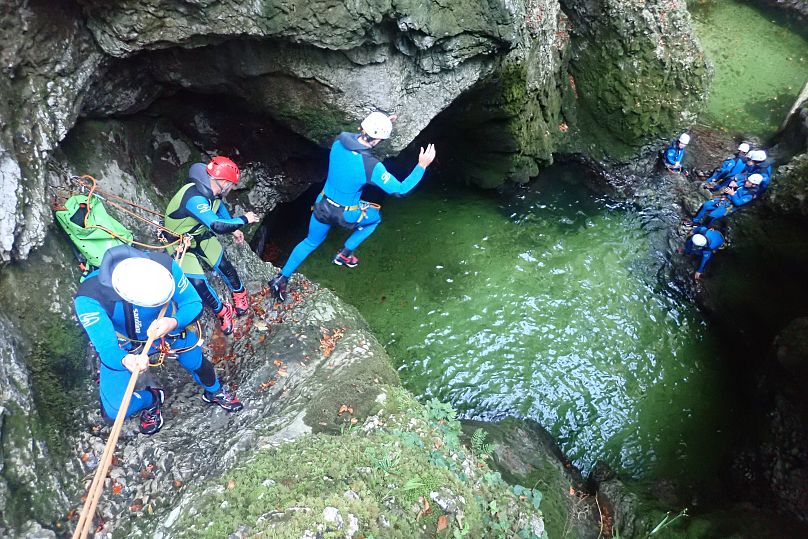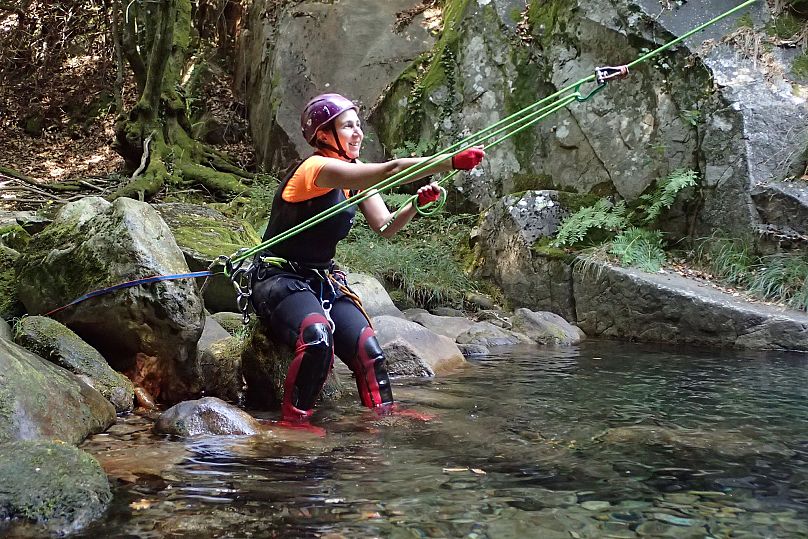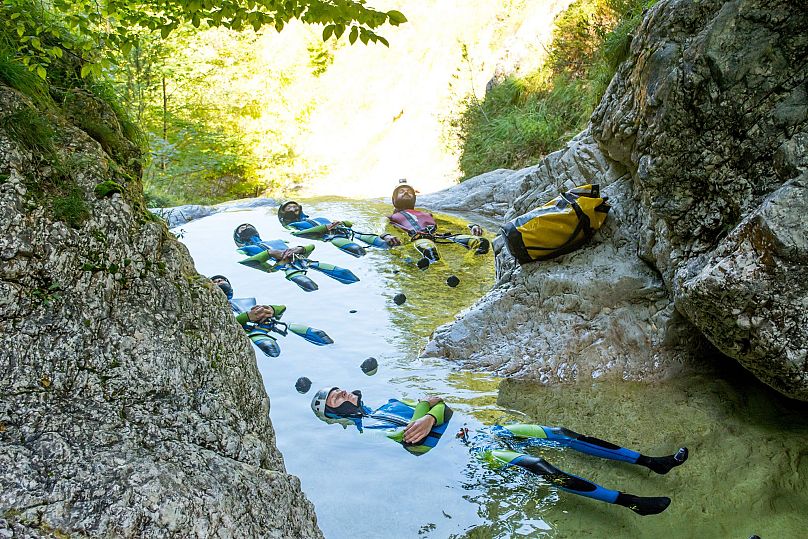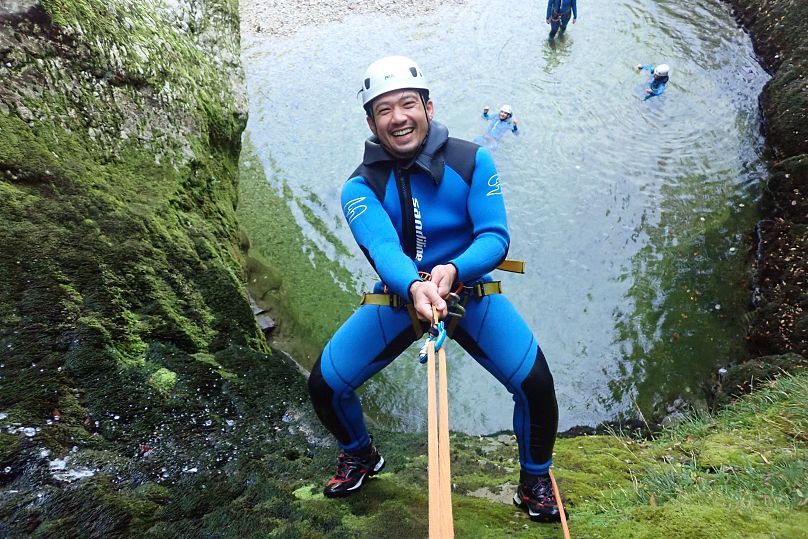I am teetering on the edge of a rock in Slovenia’s Grmečica Canyon, heart pounding as my thoughts ping-pong between my mother’s worried face and tales from Greek mythology—mainly the death bits.
A pool about five metres below glitters a translucent blue. Sunlight streams in and bounces off the water, highlighting the tawny rock walls surrounding us and the canopy of leafy trees above.
Grmečica means thunder in Slovenian, and the craggy canyon certainly feels like somewhere Zeus accidentally created with an errant lightning bolt tossed during a temper tantrum.
My left hand is vice-like, gripping the shoulder of Urban, an affable 3Glav Adventures guide with a mop of curly brown hair. He is trying to reassure me that leaping will not land me in the underworld. Below, a group of young American guys echo his encouragement.
It’s almost enough to drown out mum’s voice in my head, shrieking, “Well if all your friends jumped off a cliff, would you?”
Experienced canyoneers tell me this moment of terror is the archetypal beginning of a journey into a canyoning addiction—sometimes even a life-saving one.
The prelude? Finding out what canyoning actually is. And, as 3Glav founder Domen Kalajžič explained, it is rarely what people assume.

He said: “It was confusing at the start [of our company]. Half of the people thought they were going canoeing, half of them thought they were going rock climbing.
“Now it depends – it became quite popular in the Alps and more and more people know, but there are still some surprises.
“In this predictable world, everything is so well known in advance. I think it’s good if it’s a pleasant surprise.”
Domen compares canyoning to a “natural waterpark”. The growing sport is a combination of abseiling, swimming, sliding and jumping: think parkour through some of the world’s most stunning landscapes.
Some sites are only suitable for experienced canyoneers, but others are appropriate for children as young as five. Access and difficulty can change with the seasons, or even the weather.
Europe is rife with canyoning hotspots, from Italy’s Lake Garda to the holy grail, Switzerland’s Ticino, which tops nearly every canyoneer’s bucket list.
Ana Sousa, 51, says the sport saved her life. The special needs teacher from Portugal had a burnout 10 years ago.

She said: “I was going through my days, sitting on the sofa, going to work, from work to home, home to work, nothing more than that.
“I just couldn’t see how to get out of it. I started to take pills to sleep, pills to stay awake, pills to work. And one day one of our friends invited us to go and do canyoning for the first time.
“I was so scared. I never felt more scared in my life because it’s just a rope and many metres down there. So fear. Just pure fear.
“The minute I got down I cried. I cried a lot. And shivered a lot. And then I said, OK, this is what I need.”
Ana took a course to learn how to canyon independently, and now goes every weekend with a group she says have become like family.
She explains: “You develop a kind of kindred spirit that you don’t have in another sport. Because you have to trust the other guy.
“Putting your life in the hands of others is not easy. We don’t do that in our everyday life. We have to control everything. I used to be like that.”
Ana, who is still teaching, has now taken 99 canyon trips. She has no plans to stop.
She said: “I will probably do canyoning until I am using a walker.”

Canyoning adventures, led by experienced guides certified by the Germany-based Commission Internationale de Canyon, offer one way into the sport.
Another is through the Fédération Internationale de Canyonisme (FIC), an organisation comprised of member associations in 18 countries, including founders like France and Belgium. Zambia, its latest member, joined last year.
FIC President Sonny Lawrence encourages anyone interested in canyoning to find their local FIC chapter, where volunteers will often help newbies learn the ropes—literally.
The organisation also coordinates an annual festival attended by over 200 people from around the world.
Sonny, who describes canyoning as a team sport, said: “Our goal is to network people, whether you’re experienced or not.
“At the end of the day people are going out to dinner and chatting with people from some other country. [Lasting] relationships are formed.”
Self-described “wuss” Matej Hosner, 31, left his first canyoning experience after two jumps. But he valued perseverance, he said, so he went back—and fell in love.
The father of two now runs his own canyoning business in Slovenia, and he’s hoping to take others on their own transformative journeys.
The guide’s new venture, Canyoning Challenge Slovenia, is in collaboration with a team building expert and a psychotherapist. They will work with groups to develop a range of skills including stress management and confidence building.
He explains: “I want to teach people how to use this in everyday life. Because when you come back to your not-so-extreme life, and you face a problem, you can say, ‘Oh man, I’ve done much harder things than this.’
“You get scared but if you overcome those fears then you should grow in fortitude. So whatever you’re going through, I want you to go through it courageously.”

Matej’s intentional approach melds a range of philosophies and personal development tools, from William Hof’s cold water exposure to Joseph Campbell’s hero’s journey.
He said: “If you can manage all of this, you can come to this state of being a hero!”
Back in Grmečica, I am trying to muster my own Herculean might.
“If all your friends jumped off a cliff, would you?”
“No mum,” I silently reply. “Apparently I’ll do it for complete strangers.”
I leap.
And mid-air, just as my toes are about to hit the water, I become a hero—and an addict.

